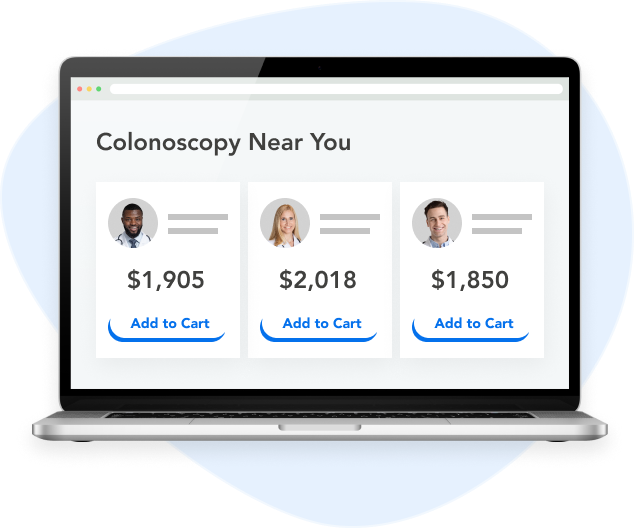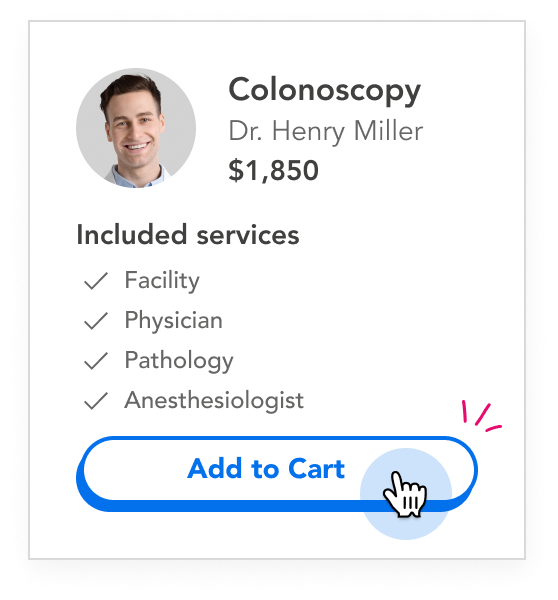Breast Biopsy in the Knoxville Region
Save by purchasing this procedure online.
Similar Procedures: Breast Biopsy (in office), Breast Biopsy - Percutaneous (in office), Breast Biopsy For Additional Lesions (per lesion)
National Average 6,133
Regional Average2,854Save $3,279
Financing Options
Promotional financing available when you pay with CareCredit. $200 minimum purchase. What is CareCredit?
Newport Medical Center
Interventional Radiology
435 Second Street
Newport, TN 37821
Offered by

Bradley Medical Center
Interventional Radiology
5.0
2305 Chambliss Avenue North West
Cleveland, TN 37311
Offered by

Jefferson Memorial Hospital Interventional Radiology
Interventional Radiology
110 Hospital Drive
Jefferson City, TN 37760
Offered by

North Knoxville Medical Center
Interventional Radiology
7565 Dannaher Drive
Powell, TN 37849
Offered by

Tennova Healthcare Turkey Creek
Interventional Radiology
10820 Parkside Drive
Farragut, TN 37934
Offered by

Boxberger, John, MD
General Surgery
4.5
2175 Chambliss Avenue NW, Suite D
Cleveland, TN 37311
Offered by

Offered by

Wenger, Eston, MD
General Surgery
4.8
Tennova Healthcare Cleveland
2305 Chambliss Ave NW
Cleveland, TN 37311
Offered by

Worthington, Joshua, MD
General Surgery
4.5
Tennova Healthcare Cleveland
2305 Chambliss Ave NW
Cleveland, TN 37311
Offered by

Money Back Guarantee
We will refund your payment in full if you end up not needing your purchased procedure and do not receive care. Details
Get Care In Three Easy Steps
Compare Upfront Prices

Search by procedure and location to browse local providers and compare upfront pricing.
Buy Your Procedure

Pay for your procedure online or by calling (844) 256-7696. Or buy your procedure at the facility before your appointment is scheduled.
Receive Your Care

Follow the scheduling instructions given by your provider. Bring your voucher to your appointment.
Frequently Asked Questions
View All FAQsBreast Biopsy Cost in the Knoxville Region
Save by purchasing this procedure online.
Breast Biopsy Cost near Farragut, TN
Breast Biopsy Cost near Powell, TN
Procedure Details
What Is a Breast Biopsy?
A breast biopsy is a procedure done to remove a small amount of tissue from your breast. The breast tissue is then analyzed to determine if it has cells that are cancerous.
When Is a Breast Biopsy Recommended?
Your doctor might recommend a biopsy of the breast if:
- You feel, or your doctor feels, an area in your breast with a small lump or other thickening
- A mammogram or ultrasound shows a lump or other abnormal characteristics in your breast
- An MRI shows something that looks abnormal or suspicious
- There is a bloody discharge or other unusual changes -- including crusting or scaling -- around your nipple
What Are the Different Types of Breast Biopsies?
There are several ways a breast biopsy can be performed. Your doctor will recommend the procedure that can obtain a good sample of tissue in the least invasive way — with the smallest incision or least disruption to your breast.
The type of biopsy necessary may depend on several factors, including:
- how large the area of suspicious tissue is
- where the suspicious tissue is located within the breast
- whether there is more than one area of suspicious tissue
- other medical or healthcare issues you might have
- your own preference of procedure
For any biopsy, even the less invasive ones, the medical team will numb the area in your breast where the biopsy is being obtained.
Some of the most common biopsies, from least invasive to more invasive, are:
Fine Needle Aspiration Biopsy
In a fine needle aspiration biopsy, you'll usually be lying down. Your doctor or surgeon inserts a thin, hollow needle -- attached to a syringe -- into your breast and draws out a very small amount of tissue from the suspicious area. The needle is smaller than those usually used to draw blood.
In some cases, fine needle aspiration will help determine if the lump is a fluid-filled cyst instead of a solid lump.
Core Needle Biopsy
In a core needle biopsy, a larger needle is used to draw out tissue. You'll also be lying down for this procedure. The surgeon or doctor will often use the needle to remove several small cylinder-shaped samples of tissue. The samples are usually about the size of a grain of rice.
Your surgeon or doctor may be able to perform the procedure without any other imaging equipment. In those cases, the procedure can be performed in your doctor's office.
In some cases, the doctor may want to use ultrasound equipment or magnetic resonance imaging (MRI) to help locate the area of concern and retrieve a sample of tissue from the right area. In those cases, the procedure will be done in a room with access to that type of equipment, like in an imaging center. During an ultrasound-guided needle biopsy, you'll lie on your side or back on a special table. During an MRI-guided needle biopsy, you'll lie face down on a special table, with your breasts fitting into a depression in the table.
Stereotactic Biopsy
This type of biopsy uses a mammogram machine to specifically locate the suspicious area. You'll typically lie face down on a padded table that has a hole for your breast. The medical provider — often a specialist doctor called a radiologist — may slightly compress or move your breast in the machine so the suspicious area can be easily seen. The radiologist then inserts either a needle or a vacuum-assisted probe into your breast and draws out tissue for testing. This procedure can take 30 minutes to an hour.
Surgical Biopsy, or Open Biopsy
In some cases, your doctor may recommend a surgical biopsy, which removes a larger part -- or sometimes the entire mass -- of the suspicious lump. A surgical biopsy is often done not only with local anesthesia but with sedation, medicine to relax you, that's given in a vein in your arm. In an incisional biopsy, the surgeon cuts through the skin with a scalpel to remove a piece of tissue. In an excisional biopsy, the surgery removes the entire area of tissue that might be cancer. In both cases, the tissue is sent to a lab for examination.
How Do You Prepare for a Breast Biopsy?
Biopsies are generally scheduled at your own convenience, though most women want them scheduled quickly after a doctor recommends one.
Depending on the type of biopsy, your doctor may recommend that you avoid taking aspirin or any other blood-thinning medications in the days before the procedure. If an MRI might be considered for the biopsy, your doctor will want to know if you have an electronic device implanted in your body -- like a cardiac pacemaker -- or if you might be pregnant. Those situations may mean an MRI isn't appropriate.
What Happens to the Biopsy Sample After It's Obtained?
A doctor called a pathologist will examine the tissue under a microscope to determine whether the sample contains cancer cells. If the biopsy shows cancer, the pathologist will examine the cells and can provide a better understanding of the specific type of breast cancer and how it might be treated.
Usually within about a week of the biopsy, the pathologist will deliver a report to your doctor, who will then contact you to provide more information.
How Often Do Breast Biopsies Find Cancer?
In the United States, a doctor's recommendation for a breast biopsy does not mean that cancer is likely present. In fact, cancer is not found in about 80 percent of U.S. women who have a breast biopsy.
What Can You Expect After a Breast Biopsy?
You'll often go home the same day as the breast biopsy. Your breast may be bandaged and you'll be provided with other bandages and an ice pack to place on the biopsy area to reduce swelling.
You will likely have bruising after some procedures, including a core needle biopsy. You will have stitches if you've had a surgical biopsy. You can take non-aspirin pain relievers like acetaminophen to help with any pain.
Sources:
https://www.breastcancer.org/symptoms/testing/types/biopsy?gclid=EAIaIQobChMIh73R6bfu4QIVsRx9Ch1RiwALEAAYASAAEgI-OvD_BwE
https://www.mayoclinic.org/tests-procedures/breast-biopsy/about/pac-20384812
https://www.cancer.org/cancer/breast-cancer/screening-tests-and-early-detection/breast-biopsy.html
https://www.nationalbreastcancer.org/breast-cancer-biopsy
Patient Reviews
5.0
What did you like most about using MDsave?
Easy and least expensive
What could we do to improve?
Nothing I can think of
What did you like most about using MDsave?
Customer service
What could we do to improve?
Not sure
What did you like most about using MDsave?
Ease of getting voucher
What could we do to improve?
Attempt to attract more physicians and medical facilities to participate
What did you like most about using MDsave?
How much money I could save.
What could we do to improve?
Send reminders.
What did you like most about using MDsave?
Simplicity of purchase and use, all items covered for one price, no lingering bills
What could we do to improve?
Be more widely available and promote your benefits to a wider audience.
Procedures
© Copyright 2025 MDsave Incorporated.
All Rights Reserved.
CPT Copyright 2025 American Medical Association.
All Rights Reserved.



